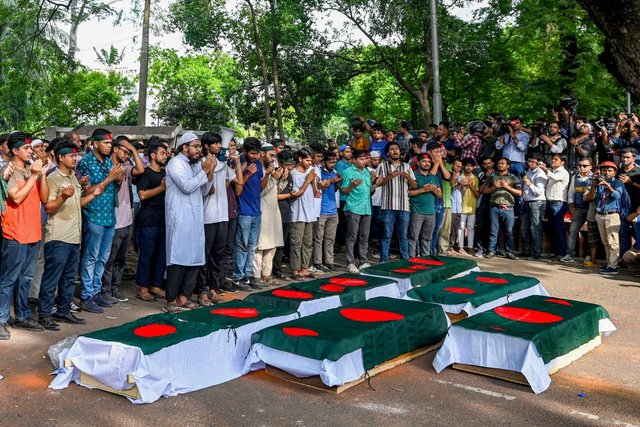Grievous Human Rights Violations in Bangladesh: More than 6,000 injured in Dhaka and over 200,000 accused

The daily Prothom Alo reports that 6,703 people were injured in clashes and conflicts surrounding the quota reform movement in the capital. The injured received treatment at 31 government and private hospitals, according to a report by Prothom Alo. The report claims these patients went to hospitals between July 16 and July 22.
Deutsche Welle's content partner, Prothom Alo, reports that their representatives visited 38 government and private hospitals in the capital from July 23 to July 27 and spoke with the authorities. Among these, 9 were government hospitals, and the remaining 29 were private hospitals.
Many people went to the hospitals after being shot with pellets, rubber bullets, or live ammunition. Others went to the hospital after being injured by bricks, sticks, or rods. Some went because they fell ill due to tear gas.
The most significant number of people injured in the clashes received treatment at the National Institute of Traumatology and Orthopaedic Rehabilitation (NITOR) or the Pangu Hospital. Information collected from the hospital on July 23 shows that 1,269 people received treatment there from July 17 to July 22, among whom 231 were shot. A total of 537 people were treated while being admitted to the hospital, meaning 42% of the patients who came to this hospital required hospitalisation.
On the afternoon of July 23, Brigadier General Md. Asaduzzaman, Director of Dhaka Medical College Hospital, told Prothom Alo that 1,071 people received treatment at their facility.
An analysis of 150 deaths

In the quota reform movement and subsequent protests and clashes, most of the deaths were among students and working-class people. According to hospital, family, and sources who brought in bodies, 210 people have died in the clashes and conflicts so far. Detailed information about the age, occupation, type of injuries, and the area where they were injured or killed is available for 150 of these individuals. Among them, 113 were children, teenagers, and young adults.
The analysis shows that most of the deceased had lethal bullet wounds on their bodies. There were pellet, rubber bullet wounds, and fewer other injuries. In many cases, autopsies were conducted, but reports have not been prepared. In many cases, families took the bodies without an autopsy.
The analysis found that 19 children and teenagers were among the deceased, including a four-year-old child. There were 94 people between the ages of 18 and 29, 21 people between the ages of 30 and 39, and 16 people aged 40 or above.
Among the 150 individuals, 25 were employees of shops, hotels, and sales centres, 16 were shopkeepers, small business owners, and street vendors, 11 were day labourers and workers in similar professions, 13 were drivers or assistants of vehicles, trucks, rickshaws, and vans, and 5 were garment factory workers. There was also one doctor among the deceased.
Over 200,000 accused in Dhaka
Nearly 200 cases were filed in various police stations in the capital regarding the recent violence surrounding the quota reform movement. Over 213,000 people have been named as accused in these cases, most of whom are unidentified.
Almost all the cases were filed by the police. According to documents, at least 16 cases have accused 5,000 and 10,000 people. As of yesterday, 229 cases have been filed in 50 police stations of the Dhaka Metropolitan Police (DMP). The Daily Star received documents for 178 cases up to July 17, including 213,834 accused individuals. Among them, only 1,310 are named charged, while the number of accused in the remaining 51 cases is unknown.
In cases with unnamed accused, law enforcement agencies can arrest anyone they wish. The police did not mention any names or numbers of accused individuals in 60 cases and accused 10,000 unidentified people in at least two instances. One of these cases occurred in front of BRAC University in Merul Badda on July 18, and the other was filed at Lalbagh Police Station on July 21, related to sabotage. The unidentified accused are members of the BNP-Jamaat alliance.
In the vandalism incident at Mirpur-10 Metro Station on July 19, the Metro Rail authorities filed a case against 9,000 unidentified people. Additionally, one case named 8,000 accused, two cases named 7,000 accused, seven cases named 6,000 accused, and three instances named 5,000 accused. Most of the accused are charged with illegal assembly, rioting, attacking law enforcement agencies, and damaging property.
Between July 17 and July 28, at least 2,506 people were brought before the court, including 98 yesterday, in connection with 158 cases.
Sources:
ঢাকায় আহত ৬ হাজারের বেশি, আসামি দুই লাখের বেশি
১৫০ মৃত্যুর বিশ্লেষণ: নিহত ১১৩ জন কম বয়সী, শিক্ষার্থী ৪৫
Bangladesh on Edge after Crushing Quota Protests
Thank you, friend!


I'm @steem.history, who is steem witness.
Thank you for witnessvoting for me.
please click it!
(Go to https://steemit.com/~witnesses and type fbslo at the bottom of the page)
The weight is reduced because of the lack of Voting Power. If you vote for me as a witness, you can get my little vote.
Upvoted! Thank you for supporting witness @jswit.